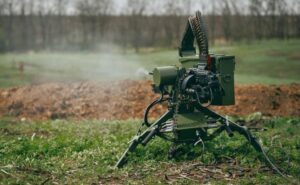Military, Government, and Arms Manufacturers at the Same Table: How Brave1 Cluster Works and How Businesses Can Obtain Grants for Development.
Ukraine Allocates UAH 1.5 Billion for Military Grants. How are these funds distributed, what is the role of the technological cluster Brave1, and what results does it yield?
When FPV drones appeared on the front lines, engineers from two countries began developing mobile electronic warfare (EW) complexes to jam their communication. As the number of such complexes increased, drones started shifting to non-standard frequencies and equipping them with artificial intelligence.
With the saturation of the front lines with drones, infantry became very vulnerable, leading to the idea of “hiding” soldiers and sending combat robots in their place. Both Russia and Ukraine already use such technology.
To avoid losing in technological races, the Ukrainian defence complex must work as a team. Designers should receive the necessary resources, the military should direct the development in the right direction, and the state should quickly conclude contracts and scale them.
Until 2023, there was no such team. Military startups drowned in a sea of bureaucracy from the General Staff and the Ministry of Defence. Developing new equipment was closed, slow, and inefficient.
Over time, Ukrainian government acknowledged its mistakes and created the Brave1 cluster.
This structure aims to bring together the army, government, and manufacturers. Its task is to create an environment in the defence industry where the state customer hears the military, manufacturing companies find investors, designers complement each other and receive grants, and bureaucratic problems are solved with a few calls.
Coordination in the development and production of advanced weapons is of paramount importance for Ukraine, especially in the face of shortages of personnel and ammunition.
More Grants to Come
Granting grants for military startups is a common practice in developed countries. The US Department of Defense has a separate organisation for this – the Defense Innovation Unit with an annual budget of $1 billion, and several such “business incubators” operate in Israel.
Mass granting of grants for the development of military technologies is a novelty for Ukraine. The idea of making the state an “angel” miltech investor is not only related to the search for a “technological” response to a larger Russian army but also to the formation of new private defense companies that require funding.
The grant issuance works as follows. The company applies to Brave1 with all the data and registers its developments. They are checked for relevance, and the manufacturer is checked for compliance with data and connections with Russia. About 80% of developments successfully pass this stage.
Next, each development goes to a team of experts from the General Staff, which includes 500 military personnel and scientists. They provide a detailed conclusion on its technological merits, such as innovativeness, readiness, and production capacities.
If the assessment is “high”, the developer is taken to the Ukrainian Ministry of Defence, where it will undergo a codification procedure, i.e., general testing and documentation. This opens the way to the first serial contract with the state.
Developments that received a “medium” assessment continue to “brew” in Brave1 until they mature. One of the tools to accelerate this process is the issuance of a grant in the amount of $5,000. These funds are issued at the decision of the supervisory board, which consists of representatives of various departments and independent experts.
The company receiving the grant must report on its spending. If the expenses do not correspond to the initial goal, the cluster initiates a refund. Grant recipients also fill out a questionnaire quarterly to assess the effectiveness of their expenses on the work done.
“We received three grants from Brave1 to improve the characteristics of another company’s drone. This helped us develop machine vision technology and integrate a thermal imaging camera,” shared Alexander Chendekov, director of FoxFour.

Roboneers “Shablya” Turret
Another well-known participant in the grant program is the company Roboneers, which already serially produces the robotic turret “Shablya”.
In the year of the cluster’s existence, the state through Brave1 issued 186 grants for $3.2 million. This is very little considering the scale of the Russian-Ukrainian war and the technological potential of the enemy.
However, in 2024, grant funding will increase to UAH 1.5 billion (37.5 million dollars), or 12 times. The maximum grant size has also increased – soon each manufacturer will be able to receive up to $200,000.
How many developments that received grants have serial contracts and are mass-produced on the front lines is unknown, so it is difficult to draw conclusions about the effectiveness of the grant program.
Brave1 assures that the primary check of companies, the reporting system, the supervisory board, and the General Staff experts act as safeguards against fraud and abuse of office.
Ukraine’s Defence Sector Learns to Communicate
Another challenge for Brave1 is to facilitate communication among players in the arms market, which has traditionally been weak in Ukraine.
Selling military equipment to the state is not easy. The development must meet the frontline needs, and the military must learn about it.
Then the commanders must list this development in the list of needs and pass the information to the Ministry of Defence for procurement.
There is never enough money for all the equipment requested by the military, so the Ministry of Defence and the General Staff prioritise. Only if the equipment is a priority, there is enough funding for it, and it has undergone testing and codification, the Ministry of Defence concludes a serial contract with the manufacturer.
Navigating this process is no simple feat. Companies, particularly newcomers, often struggle to identify the appropriate office to approach, the key decision-makers to engage with, how to capture the military’s interest, and what currently holds priority for the armed forces. Such disorder amplifies business risks for private arms manufacturers and deters investors from engaging in miltech ventures.
How Brave1 is solving this problem
Firstly, the cluster orchestrates demonstration tests and gatherings, facilitating direct communication between military officials and manufacturers to fine-tune developments accordingly. “We were part of an event where the head of the Electronic Warfare (EW) department within the Armed Forces engaged directly with manufacturers. This unprecedented interaction signifies a significant shift,” highlighted Sergey Skoryk, a representative from Kvertus.
Secondly, Brave1 conducts public campaigns aimed at identifying solutions. This ensures manufacturers are aware of military requirements and government procurement preferences.
For instance, there’s a current demand for UAV (Unmanned Aerial Vehicle) interceptors tailored for large reconnaissance UAVs, along with countermeasures against Russian FPV (First Person View) and commercial drones. Additionally, the cluster prioritises the development of robotic platforms, close-range EW (Electronic Warfare) systems, and artificial intelligence for drone operations.
Thirdly, Brave1 fosters collaboration among developers and facilitates partnerships when needed. According to the cluster, there have been more than 30 collaborations between different developer teams over the past year.
“For instance, one manufacturer possessed a logistics platform, while another had a low-profile turret. Recognising the synergy between their products, they decided to merge their efforts, envisioning an efficient robotic complex.
In another instance, upon receiving feedback from the military regarding an issue with power supplies in an electronic warfare system, we connected the manufacturer capable of addressing this concern with the EW system developer. This collaboration resulted in a significantly enhanced radio-electronic warfare tool,” explained representatives of Brave1.
After the start of the large-scale war, the Ukrainian defence sector made a sharp turn towards the private sector, so the success of manufacturers largely depends on investments. To make their attraction more productive, Brave1 organises so-called Invest Days to introduce developers and investors to each other.
One such event took place in Warsaw, where developers could communicate not only with domestic investors but also with foreign ones.
“Thanks to ‘Brave,’ we met a foreign investor and maintain contact with him. We now know the terms on which we can attract funding if we run out of money,” shared Chendekov.
Investors can also contact Brave1 themselves to find promising startups. The cluster notes that there are already cases of successful private investment attraction through such events.
Streamlining Codification Procedures
Presently, Brave1 oversees the registration of over 1,700 developments, yet only 60 are eligible for state contracts after undergoing codification at the Ministry of Defense. These are military assets whose quality and manufacturing capabilities are assured by both the state and the respective company.
In pre-war times, the codification process could extend over several years. However, today, it has been condensed to a matter of months. While codification has become more straightforward, specialists at Brave1 remain instrumental in assisting with documentation preparation, organising testing procedures, and offering guidance on the intricacies of state contracting.
“Amidst the myriad steps required for codification, Brave1 consistently lends us a guiding hand. They provide invaluable direction on letter composition, office navigation, and facilitate introductions to essential commanders. Their support ensures that bureaucratic hurdles don’t impede progress,” summarised Skoryk.
Ukraine is forging ahead with the construction of a robotic army. But when will these mechanized soldiers see action?
The swifter manufacturers traverse the path from conception to codification, the broader the array of equipment the state can procure, providing the military with a more technologically adept response to adversaries’ advancements. Efforts to expedite these processes further are currently underway.
Throughout the extensive conflict, the defense sector garnered substantial state orders. Yet, for this equipment to prove its mettle, robust business connections and a dynamic innovation ecosystem must be established. Recognizing this imperative, the Ukrainian government embarked on implementation only in the war’s ninth year.
Read also:
Fostering Defence Tech Innovation: Introducing MITS Accelerator in Ukraine
Click here for more on Business & Economy at EU Today
______________________________________________________________________________________________________________





